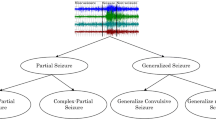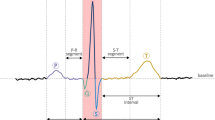Abstract
In this research paper we present designing and evaluating the electrocardiography (ECG) and Myoelectric signal (EMG) pattern recognition methods based on the adaptive machine learning. For this theoretical model to describe how the Boundary Misclassification Risk (BMR) changes along parameters including, the adaptive learning times, the adaptive learning frequencies, the generalization ability of the predictive model, and the ratio of samples without supervised information during the adaptive learning were proposed. The models are built up based on the formulated adaptive learning process of the myoelectric signal recognition, and the classification from the measured electrocardiogram (ECG) pattern. The theoretical model can be regarded as the extensions of current statistical learning theory and domain adaption theory. In the experiment, the maximum error rate (MER), and the average error rate (AER) of the RCS is employed as the approximation of the BMR. During the experiment, MER and AER change tendency matches the theoretical BMR change tendency. For different learning time interval AER is presented, from the result tendency match with the experimental and theoretical evaluated value is confirmed. Hence, the proposed theoretical model can be used for ECG and EMG pattern matching.









Similar content being viewed by others
References
Amsuss, S., Goebel, P., Jiang, N., Graimann, B., Paredes, L., & Farina, D. (2014). Self-correcting pattern recognition system of surface EMG signals for upper limb prosthesis control. IEEE Transactions on Biomedical Engineering, 61(4), 1167–1176.
Balasubramanian, K., Donmez, P., & Lebanon, G. (2011). Unsupervised supervised learning ii: Margin-based classification without labels. Journal of Machine Learning Research, 15(6), 137–145.
Cao, J., Zhang, K., Luo, M., Yin, C., & Lai, X. (2016). Extreme learning machine and adaptive sparse representation for image classification. Neural Networks, 81, 91–102.
Dapeng, Y., Yikun, Gu, Li, J., Luke, O., & Hong, Liu. (2017). Dynamic training protocol improves the robustness of PR-based myoelectric control. Biomedical Signal Processing and Control, 31, 249–256.
Donmez, P., Lebanon, G., & Balasubramanian, K. (2014). Unsupervised supervised learning I: Estimating classification and regression errors without labels. Journal of Machine Learning Research, 11(2), 1323–1351.
Earley, E. J., Hargrove, L. J., & Kuiken, T. A. (2016). Dual window pattern recognition classifier for improved partial-hand prosthesis control. Frontiers in Neuroscience, 10, 1–12.
Enzo, M., Johan, A., Eva, L., Liselotte, H., Bo, H., & Max, C. (2018). An alternative myoelectric pattern recognition approach for the control of hand prostheses: A case study of use in daily life by a dysmelia subject. IEEE Journal of Translational Engineering and Health Medicine, 6, 2600112.
Guo, S., Pang, M., Gao, B., Hirata, H., & Ishihara, H. (2015). Comparison of sEMG-based feature extraction and motion classification methods for upper-limb movement. Sensors, 15(4), 9022–9038.
Jie, Z., Shufang, W., Xizhao, W., Guoqing, Y., & Liyan, M. (2018). Multi-image matching for object recognition. IET Computer Vision, 12(3), 350–356.
Kobayashi, M. (2013). Hyperbolic Hopfield neural networks. IEEE Transactions on Neural Network and Learning System, 24(2), 335–341.
Kobayashi, M. (2018). Stability of rotor hopfield neural networks with synchronous mode. IEEE Transactions on Neural Network and Learning System, 29(3), 744–748.
Kuznetsov, V., & Mohri, M. (2016). Generalization bounds for non-stationary mixing processes. Machine Learning, 106(1), 1–25.
Liu, J., Sheng, X., Zhang, D., He, J., & Zhu, X. (2016). Reduced daily recalibration of myoelectric prosthesis classifiers based on domain adaptation. IEEE Journal of Biomedical Health Informatics, 20, 166–176.
Marina, M. C., et al. (2016). Improving the robustness of myoelectric pattern recognition for upper limb prostheses by covariate shift adaptation. IEEE Transactions on Neural Systems Rehabilitation Engineering, 24(9), 961–970.
McCool, P., Chatlani, N., Petropoulakis, L., Soraghan, J. J., Menon, R., & Lakany, H. (2014). Lower arm electromyography (EMG) activity detection using local binary patterns. IEEE Transactions on Neural System Rehabilitation Engineering, 22(5), 1003–1012.
Meng, D., Jia, Y., & Du, J. (2016). Finite-time consensus for multiagent systems with cooperative and antagonistic interactions. IEEE Transactions on Neural Network and Learning System, 27(4), 762–770.
Pei, J. L., & Chen, H. Y. (2018) Design and implement of a rehabilitation system with surface electromyography technology. In IEEE international conference on applied system invention (ICASI).
Pronobis, A., Jie, L., & Caputo, B. (2010). The more you learn, the less you store: Memory-controlled incremental SVM for visual place recognition. Image Vision Computing, 28(7), 1080–1097.
Radhika, M. (2017). Study on interaction between temporal and spatial information in classification of EMG signals for myoelectric prostheses. IEEE Transactions on Neural System and Rehabilitation Engineering, 25(10), 1832–1842.
Smith, L. H., Kuiken, T. A., & Hargrove, L. J. (2014). Real-time simultaneous and proportional myoelectric control using intramuscular EMG. Journal of Neural Engineerng, 11(6), 066013. https://doi.org/10.1088/1741-2560/11/6/066013.
Sun, Y., Tang, K., Zhu, Z., & Yao, X. (2017). Concept drift adaptation by exploiting historical knowledge. IEEE Transactions on Neural Networks & Learning Systems, 99, 1–11.
Toledo Perez, D. C., Martinez Prado, M. A., Gomez Loenzo, R. A., Paredes Garcia, W. J., & Rodriguez Resendiz, J. (2019a). A study of movement classification of the lower limb based on up to 4-EMG channels. Electronics, 8(259), 1–11.
Toledo Perez, D. C., Rodriguez Resendiz, J., Gomez Loenzo, R. A., & Jauregui-Correa, J. C. (2019b). Support vector machine-based EMG signal classification techniques: A review. Applied Sciences, 9(4402), 1–28.
Vapnik, V. N. (1999). The nature of statistical learning theory (2nd ed.). New York: Springer.
Wei, L., & Huang, J. (2018). Cooperative adaptive output regulation for second-order nonlinear multiagent systems with jointly connected switching networks. IEEE Transactions on Neural Network and Learning Systems., 29(3), 695–705.
Zhao, Z., et al. (2018). Robust adaptive embedded label propagation with weight learning for inductive classification. IEEE Transactions on Neural Network and Learning System., 29(8), 3388–3403.
Zhihuai, X., Zhenhua, G., & Chengshan, Q. (2018). Palmprint gender classification by convolutional neural network. IET Computer Vision, 12(4), 476–483.
Acknowledgements
The Authors would like to thank the Indian Institute of Technology, New Delhi for providing Research fellowship (INSA-2018 ENGT92). Management and Principal of Mepco Schlenk Engineering College (Autonomous), Sivakasi, Tamil Nadu for providing us the necessary facilities to carry out our research work.
Author information
Authors and Affiliations
Corresponding author
Ethics declarations
Conflict of interest
All authors declare that they have no conflicts of interest.
Ethical approval
This article does not contain any studies with human participants or animals performed by any of the authors.
Informed consent
Informed consent are not necessary.
Additional information
Publisher's Note
Springer Nature remains neutral with regard to jurisdictional claims in published maps and institutional affiliations.
Rights and permissions
About this article
Cite this article
Jeyaraj, P.R., Nadar, E.R.S. Adaptive machine learning algorithm employed statistical signal processing for classification of ECG signal and myoelectric signal. Multidim Syst Sign Process 31, 1299–1316 (2020). https://doi.org/10.1007/s11045-020-00710-7
Received:
Revised:
Accepted:
Published:
Issue Date:
DOI: https://doi.org/10.1007/s11045-020-00710-7




